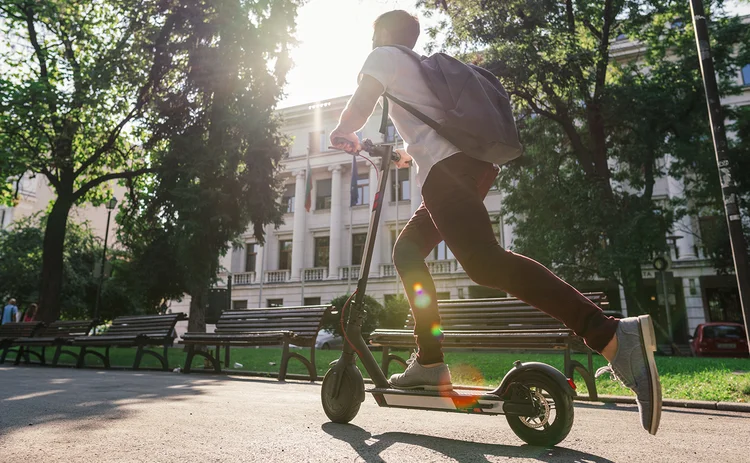
Analysis: Illegal e-scooters hit insurer claims reserves to tune of 'hundreds of thousands'

Insurers are already reserving ‘hundreds of thousands’ of pounds for collisions involving third-party private e-scooters – but the vehicles aren’t legal on public roads yet.
They may be illegal to use on public roads for now, but - whether due to riders being unaware of the rules or wantonly flouting them - private e-scooters are already starting to carve out a dent in some motor insurers' claims figures.
One major motor insurer told Post it has seen around 50 claims potentially involving third-party e-scooters, against which it is holding reserves of several hundred thousand pounds. The insurer holds data on the use of the majority of these e-scooters, with more than 80% of incidents involving privately owned e-scooters operating outside of recognised Department for Transport e-scooter pilot schemes at the time the collision occurred. Injuries seen ranged from relatively minor to a handful of claims of moderate injury severity.
Another UK motor insurance giant, Aviva, not part of any trial scheme, is believed to have “hundreds of thousands of pounds” worth of claims stemming from e-scooter incidents – it was not known whether these involved public or private ones – a source outside the business told Post, though the insurer declined to verify this.
Head of expert motor at Zurich, Julie Watson confirmed it has received eight e-scooter claims across its motor team and one in its highways claims team. Only one e-scooter involved belonged to a scheme.
In numbers
- 31 trials
- 54 areas in England
- At the end of November there were 23,141 e-scooters available to rent and 66,000 had been approved. Around 13 million trips had been taken, over 18.5 million miles travelled, with around three million hours ridden in total. And around one million people had rented an e-scooter as part of a trial.
Three of Zurich's cases involved fairly serious injuries. Among these were head injuries, fractures, sprains and lacerations.
Admiral does not collect data on whether e-scooter claims involved trial vehicles, but told Post it has seen an increase in incidents into 2021.
Admiral deputy head of claims Justin Gavin said: “Last year, we saw a spike in the number of incidents reported to us involving e-scooter riders, with 129 registered throughout the year. Although this may not sound like a lot it’s more than double the number we had in 2020."
Push back
Since July 2020 more than 30 government sanctioned e-scooter trials have taken place across England, yielding three million hours' worth of journey data.
And yet the Department for Transport has again pushed back trial end dates, this time to November 2022. It could be well into 2023 by the time legislators sink their teeth into them, if indeed they do at all. Crucially for insurers, it has yet to be decided how or, whether the vehicles will be covered at all, should the government give the green light to personal e-scooters - and whether mandatory insurance will be required and how, or if, they will be regulated.
Amid delays, a lack of public awareness and the regulation gap around private e-scooters has led to a spurt of the vehicles on roads (and sometimes pavements), with the government left skirting around a data black hole. Nobody quite knows just how many e-scooters there are, let alone how they are being used.
Baroness Randerson told a Lords Grand Committee in January: "In my view, the Department for Transport is treating the 31 pilot projects rather as the Prime Minister is treating the Sue Gray report as an excuse for lack of action, while the evidence mounts and everyone can see there is a big problem."
Baroness Vere of Norbiton, the parliamentary under-secretary of state for the DFT, was forced to stress that public schemes are "trials, not experiments".
Lady Vere pointed out that "substantial additional data" had been generated since June, coming from trial operators, as well as survey and interview data.
But what Lady Vere did not refer to was data on how private e-scooters, illegal on public roads, have been used.
In numbers
Department for Transport's best estimate for the full year year ended December 2020:
- 460 accidents involving e-scooters
- 484 casualties, 384 of which were e-scooter users.
- One fatality
- 128 seriously injured and 355 slightly injured.
Data gap
The government's latest available road traffic report shows that for the year 2020 there were 280.6 billion vehicle miles travelled on Great Britain's roads.
It now also has data on over 18.5 million miles travelled by pilot e-scooters, according to Lady Vere, captured beginning July 2020 and to the end of November 2021.
All trial e-scooter miles travelled and captured over this 16 month period would account for just 0.007% as a proportion of vehicle miles travelled for 2020 alone (or 18.5 million out of 280.6 billion).
And yet, Post’s calculations show that, based on DFT estimates, e-scooters were involved in 0.42% road casualties reported by police forces for 2020 (484 out of 115,584), rising to 0.79% for the year ending June 2021 (931 out of 117,633) – or more than 50 then 100 times greater than they sit as a proportion of miles travelled for a year.
It's worth noting that 2020 saw fewer cars on the road due to Covid-19 so either e-scooters are punching well above their weight in terms of casualties and a huge hazard, or – far more likely – there is a missing piece.
And, according to some, this is a gaping information pothole that threatens to unseat legislators and road users.
Alistair Kinley, director of policy and government affairs at law firm BLM, said: “Widespread illegal use of e-scooters is endemic. Police enforcement is, at best, patchy. There are at least ten times as many illegally-used privately owned e-scooters as there are ones authorised within the trials.
"Although the monitoring of the trials will give policymakers some details of accident and safety data, it simply won’t provide a full picture of the risks posed by e-scooters.”
Data sharing agreements mean that trial operators have to keep the DFT informed about accidents. However, it is highly likely that private e-scooter collisions are underreported.
In the DFT’s own words: “Non-fatal casualties for e-scooter users are among the most likely to be under-reported in road casualty data since they have no obligation to inform the police of collisions.”
Different beasts
There are key differences between e-scooters that are part of valid schemes and their private cousins.
Trial e-scooters can have their speeds capped in particular areas and at point of manufacture, with the national speed limit for trial scooters 15.5 miles per hour.
Higher end e-scooters on the market, retailing in excess of £5000, can hit speeds of up to 68mph with this varying widely between makes and models at different price points.
While lights and bells (or horns) are a must for trial e-scooters, which can be adapted by hire companies if the government flags a problem, as yet there are no such requirements for those to be included on those built for private use. And trial e-scooters, unlike privately-owned ones, for which the rules remain up in the air, have to be insured by the rental operator and require a user to prove they are an adult with a provisional driving licence.
Penalties for those caught riding their own e-scooters on public roads include a £300 fine and up to six points off a rider's licence for having no insurance. The vehicles can also be confiscated, while the same drink driving restrictions as for cars are in place.
In the run up to Christmas, police forces and councils – such as Knowsley – rushed to caution parents that an e-scooter would not make a suitable child’s gift.
“While we understand parents may be buying e-scooters and e-bikes so their child can have fun, they are dangerous and also illegal. We urge people not to buy these items,” Shelley Powell, Knowsley Cabinet Member for Communities and Neighbourhoods felt the need to caution in early December.
It was a Christmas chorus also joined by the Association of British Insurers, which pushed out its own "think twice" before buying warning.
There are question marks over public awareness, in some cases even among senior figures.
Police Scotland drew ire from rival ministers last year after no action was taken against Scottish First Minister Nicola Sturgeon, who was pictured riding an e-scooter while campaigning. There are no government sanctioned e-scooter schemes in Scotland.
Which has previously reported most, but not all, retailers warn potential buyers of pitfalls around illegal use. And late last year a Daily Mail investigation uncovered e-scooters being sold on Amazon advertised as "perfect [...] for commuting".
Some groups have called on the government to ensure that when, or if, private e-scooters become legal for use on public roads they should be highly regulated - the Parliamentary Advisory Council for Transport Safety, for example, has made a raft of interim recommendations including that vehicles must be designed safely, with anti-tampering measures and maximum possible motor power and speed.
However, exactly how many have already been sold (the Bicycle Association has estimated at least 200,000, though other sources tentatively told Post this could be 500,000 or more), how many are vehicles that may not match up to any impending requirements if these are put in place, and how clued up their buyers are about the law, remains unclear.
Meanwhile current differences mean there is scope for rider behaviour to vary widely depending on whether they are on their own e-scooter or a scheme's one, raising questions around how representative pilot e-scooter data will be.
In numbers
Pacts reports at least 14 fatalities involving e-scooter use so far.
DFT best estimate for the year June 2020 to June 2021:
- 882 accidents involving e-scooters
- 173 were single vehicle accidents, around 20% of all e-scooter accidents
- 931 casualties in accidents involving e-scooters, of which 732 were e-scooters users.
- Three fatalities (all e-scooter riders).
- 253 seriously injured and 675 slightly injured.
Should stringent requirements be placed on the vehicles, Thatcham Research director of research Matthew Avery predicted this would be done retrospectively, meaning any already purchased and manufactured that did not comply, for example by reaching too high speeds, would be deemed illegal.
Though he queried: “Who's going to police that?”
Avery was sceptical that the government wishes to move in this direction of travel.
He explained: “There’s a couple of things at play here. The public attitude, not thinking about the road safety and liability and legality of them, is just that this is an extension of walking, this is fast walking.
“And I believe that's what the government wants to see – that half the people on the tube have got one of these under their arm [e-scooters are currently banned on London tubes due to fire safety concerns], and they get on them and relieve congestion. And the government's view on it is not clear as to: how much do we want to regulate this? And at what point is regulation a disincentive to using them? If I've got to wear a helmet and be registered, I'll get a taxi - forget all that nonsense."
He continued: “So it's not clear to me how much of the regulation the government will accept, and in delaying the announcement, that plays in their favour as well, because more people will be using them unregulated. And do you get to a point whereby there are so many of them that there's no point in regulating them?”
Avery highlighted that the research body and insurers would like to see e-scooters regulated as motor vehicles, cautioning that there are "definite safety issues with them not being regulated, such as lack of lights, lack of brakes, lack of personal protective equipment".
Where does liability lie?
Personal injury lawyer Ben Pepper, partner at Bolt Burdon Kemp, believes he has taken on a client with a case that could well be a "test" for the market.
The e-scooter rider, who was wearing a helmet and hi-vis, was clipped by the mirror of an overtaking bus while riding a private e-scooter, Pepper told Post his client suffered broken ribs, a dislocated shoulder and a punctured lung followed by pneumonia due to the incident and is likely to seek in the region of "tens of thousands" of pounds.
The case is still in early stages, but Pepper highlighted a 2015 case, McCracken vs Smith, that he argued could show that the "illegal actions of the claimant don't have have any bearing on the negligence of the defendant".
Pepper said of his case: "The e-scooter rider could just as easily have been a cyclist or pedestrian or another type of vulnerable road user who the driver should have seen and taken reasonable care to avoid. And in my client's particular case, he was wearing high visibility clothing. So, even though he shouldn't have been there, it doesn't detract from the negligence of the bus driver for not seeing."
Insurance lawyers were sceptical that the case would go much further. Plexus Law partner Joanne Pizzala commented that publicity around the case, which appeared in national newspapers including The Times and the Daily Mail, "was a clear advert" drumming up business for the law firm, querying where funding might come from.
Adding: "It's going to be quite a brave test case, particularly when the law states that the public use of e-scooters are illegal [unless rented as part of a recognised scheme]. This is a hurdle that needs to be overcome."
However, Jonathan Hodgkinson, Weightmans partner, said: “To describe this incident as a test case is perhaps misleading. While it may be the first e-scooter case that could reach court stages, the legal position is not new – any road user can pursue a claim for injury and damage caused by the negligence of another.
“In this case, even though it remains illegal to ride an e-scooter on public roads, the rider can nonetheless pursue the claim on the basis it was caused by the negligence of a driver."
He added: "Illegality of use is one tool that will help establish a picture of contributory negligence, but is not enough in itself to see a case thrown out. In addition, the usual contributory negligence arguments would apply that would in any vulnerable road user accident."
Casualties and collisions
Data around the privately-owned vehicles is patchy.
For 2020, the DFT reported there were 460 accidents involving e-scooters. For the year ending 31 June 2021, this had risen to 882. It did not distinguish whether the vehicles were part of pilots or privately owned.
“At this point we are not yet able to fully assess the quality’ of the e-scooter data captured in STATS19, in terms of consistency of recording practice for e-scooters across different police force areas, so data should be treated with caution,” the DFT warned.
To tackle the data dearth, the vehicles will soon be given a classification under ‘powered personal transporter’. However, the need for force-wide IT changes may not make this possible until 2024.
Post's own data collected from freedom of information requests to police forces in June 2021, requesting e-scooter road traffic collision data broken down by whether vehicles were privately owned or not, confirmed a scattergun approach among police forces.
Forces' data controllers cited difficulties in collecting and verifying data on the vehicles, meaning those that did submit were wary logs would not tell the full story.
Some forces, such as Merseyside, North Yorkshire and the Met Police, refused Post’s request in entirety as it would be too costly. Indeed Merseyside had not provided figures of any casualties to the DFT, despite a flurry of local media reports indicating accidents had occurred in the area. Others, such as Staffordshire, were able to say whether the road traffic collisions identified involved private or trial vehicles – but were unsure on others. But across many forces that were able to respond it was clear that private e-scooters were involved in incidents outside of trial areas, including serious collisions (see map for responses where data was supplied). For some forces, private e-scooter incidents outnumbered trial RTCs.
Pacts
Pacts is attempting to piece together what it believes may be the best available data set on privte e-scooter use for 2021 with the backing of a Road Safety Trust grant. However, the charity has pointed out it is working from “sparse and disconnected” information. Current sources include hospital units, as well as local news reports, social media updates, Motor Insurers’ Bureau, some insurer and DFT figures. Pacts has been given IPCC backing to access police data - but forces have been slow to respond. So far it has logged just under 350 injury collisions across both types of e-scooter, lower than the DFT's figure of 502 for the first six months of the year.
Davies set out: “We are concerned that the data is inadequate, it's not measuring the full story, and it's probably particularly missing out casualties involving pedestrians where they've been whacked on the pavement. Because pedestrians don't tend to go to the police unless it's very severe."
Accidents and emergencies?
King’s College Hospital by itself reported 196 casualties from e-scooter incidents in 2020 – equivalent to 40% of the DFT’s 484 reported total casualties for the year, which Pacts' Davies suggested means the DFT's number is likely to be an "underestimate".
In the North West, where 30 casualties were logged by the DFT for the year ending June 2021, 91 people were referred to orthopaedic units in Liverpool alone after either falling off e-scooters or hitting a stationary object between October 2020 and July 2021, while one person was referred after being hit by another vehicle. Two-thirds said they had been using rental devices, but Pacts has cautioned that fear of prosecution may have affected their response.
In contrast, the DFT had logged 173 single vehicle accidents, or less than double the number that presented at the Liverpool hospitals, for the whole of Great Britain in the year up to June 2021.
Injuries could have been inflicted on private land.
Findings from hospitals (see box right) appear to back up the likelihood of incidents going underreported.
Davies argued: “The government is genuinely undergoing second thoughts and uncertainty [about e-scooters]. Twelve months ago it would have just said 'let's get on with it, roll them out, have the trials, I'm sure they're fine. And we'll legalise these things.' Now it is recognising that there are safety issues, anti-social behaviour issues and a whole range of issues. And it's not quite as simple and cosy as it thought."
The executive director urged insurers that hold data for 2021, or on any "notable" incidents, to get in touch.
Insurers are key stakeholders in what happens next. They will want government to have a clear field of vision then, rather than papering over a potential pothole, to establish whether this particular micro-mobility craze signals underwriting opportunity, claims headache, or 'on your bike'.
Motor and Mobility Conference
The challenges facing the motor insurance market are daunting as the pace of change moves up through the gears. The industry, the manufacturers, the law, technology are all in the fast lane – but do you know where that journey will end? This is the conference that will help answer that vital question.
Bringing together hundreds of attendees, including senior representatives from the UK’s leading insurers, regulators and motor manufacturers, Post’s Motor & Mobility Conference explores the key issues currently facing the motor insurance sector.
To find out more, click here: Motor & Mobility Conference
Only users who have a paid subscription or are part of a corporate subscription are able to print or copy content.
To access these options, along with all other subscription benefits, please contact info@postonline.co.uk or view our subscription options here: https://subscriptions.postonline.co.uk/subscribe
You are currently unable to print this content. Please contact info@postonline.co.uk to find out more.
You are currently unable to copy this content. Please contact info@postonline.co.uk to find out more.
Copyright Infopro Digital Limited. All rights reserved.
As outlined in our terms and conditions, https://www.infopro-digital.com/terms-and-conditions/subscriptions/ (point 2.4), printing is limited to a single copy.
If you would like to purchase additional rights please email info@postonline.co.uk
Copyright Infopro Digital Limited. All rights reserved.
You may share this content using our article tools. As outlined in our terms and conditions, https://www.infopro-digital.com/terms-and-conditions/subscriptions/ (clause 2.4), an Authorised User may only make one copy of the materials for their own personal use. You must also comply with the restrictions in clause 2.5.
If you would like to purchase additional rights please email info@postonline.co.uk








